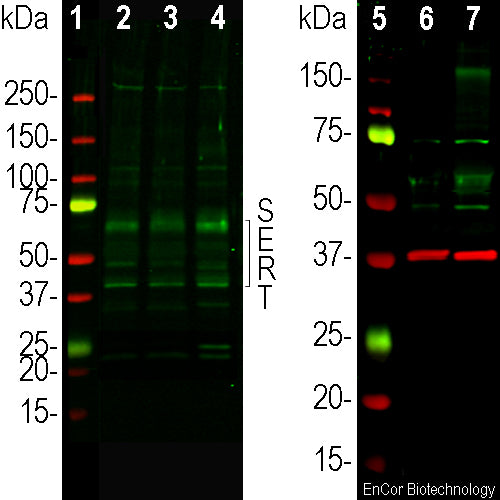

EnCor Biotechnology
Rabbit Polyclonal Antibody to Serotonin Transporter (SERT), Cat# RPCA-SERT
Description
The RPCA-SERT antibody was made against a peptide identical to the C-terminal 21 amino acids of the human serotonin transporter (SERT) and can be used to visualize serotoninergic neurons and their processes in cell culture and in sectioned material. The homologous rodent peptide differs by one conservative amino acid substitution and we have shown that this antibody works well on rodent and bovine tissues and, based on sequence conservation, is expected to be widely applicable to other mammals. We document that the antibody works well for IF, ICC and IHC on formalin fixed paraffin embedded sections, see data under the "Additional Info" tab..
- Cell Structure Marker
- Cell Type Marker
- Epitope Mapped Antibodies
- Immunohistochemistry Verified
- Pathology Related Marker
- Rabbit Polyclonal Antibodies
Add a short description for this tabbed section
| Immunogen: | KSITPETPTEIPCGDIRLNAV coupled to KLH |
| HGNC Name: | SLC6A4 |
| UniProt: | P31645 |
| Molecular Weight: | ~68kDa by SDS-PAGE |
| Host: | Rabbit |
| Species Cross-Reactivity: | Human, Cow, Rat, Mouse |
| RRID: | AB_2744658 |
| Format: | Immunogen affinity purified antibody at 1mg/mL in 50% PBS, 50% glycerol plus 5mM NaN3 |
| Applications: | IF/ICC, IHC |
| Recommended Dilutions: | IF/ICC, IHC: 1:2,000-5,000. |
| Storage: | Store at 4°C for short term, for longer term store at -20°C. Stable for 12 months from date of receipt. |
Serotonin, also known as 5-hydroxytryptamine, is an important neurotransmitter in the CNS and has many important functions outside the CNS (1). Serotoninergic neuron cell bodies in the CNS are found in the raphe nucleus and send their fine beaded processes throughout the brain and spinal cord. The serotoninergic system modulates mood, perception, emotion, aggression, stress responses, sleep and appetite and contributes to learning and memory formation. The processes of serotoninergic neurons express the Na+/Cl- dependent serotonin transporter (SERT), which is responsible for uptake of serotonin from the extracellular space following synaptic release. SERT is a member of the neurotransmitter sodium synporter family of proteins, which includes transporters specific for dopamine, GABA, glycine and other important small molecules. These transporter proteins are localized in the plasma membrane and have a complex structure including 12 transmembrane domains (2). SERT is only expressed in serotoninergic neurons and their processes so that SERT antibodies are useful to study these important cells and their processes (3-5). The SERT molecule functions by exchanging extracellular serotonin with Na+ and Cl- ions and is dependent on the membrane potential and ionic gradients generated by the Na+/K+ ATPase. A large class of drugs, the selective serotonin reuptake inhibitors (SSRIs), bind to SERT and inhibit it, increasing the level of extracellular serotonin. These drugs are important anti-depressants including the well known drug Prozac (a.k.a. fluoxetine, 6).

Chromogenic immunostaining of a 4% PFA fixed paraffin embedded mouse midbrain section with rabbit pAb to serotonin, RPCA-SERT, dilution 1:2,000 detected with DAB (brown) using the Vector Labs ImmPRESS method and reagents with citrate buffer retrieval. Hematoxylin (blue) was used as the counterstain. In this image, the RPCA-SERT antibody specifically labels the processes of serotonergic neurons passing through the midbrain. This antibody performs well in testing with 4% PFA and standard NBF fixed mouse, rat and human tissue. Mouse select image for larger view.
1. Berger M, Gray JA, Roth BL. The expanded biology of serotonin. Annu. Rev. Med. 60:355-66 (2009).
2. Coleman JA, Green EM, Gouaux E. X-ray structures and mechanism of the human serotonin transporter. Nature 532:334-9 (2016).
3. Qian Y, et al. Identification and characterization of antidepressant-sensitive serotonin transporter proteins using site-specific antibodies. J. Neurosci. 15:1261-74 (1995).
4. Nielsen K, Brask D, Knudsen GM, Aznar S. Immunodetection of the serotonin transporter protein is a more valid marker for serotonergic fibers than serotonin. Synapse 59:270-6 (2006).
5. Miner LH, Schroeter S, Blakely RD, Sesack SR. Ultrastructural localization of the serotonin transporter in superficial and deep layers of the rat prelimbic prefrontal cortex and its spatial relationship to dopamine terminals. J. Comp. Neurol. 427:220-34.
6. Wong DT, et al. A selective inhibitor of serotonin uptake: Lilly 110140, 3-(p-trifluoromethylphenoxy)-N-methyl-3-phenylpropylamine. Life Sci. 15:471-9 (1974).
7. Shaw G, et al. Preferential transformation of human neuronal cells by human adenoviruses and the origin of HEK 293 cells. FASEB J. 16:869-71 (2002).
Add a short description for this tabbed section





